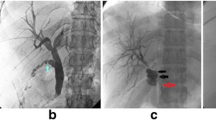Abstract:
Percutaneous recanalization of the bile duct is essential for placing biliary stents and carrying out other interventions. This prospective study was performed to establish safe approaches for percutaneous recanalization of the bile duct when it had previously resulted in failure. Between July 1995 and July 1999, percutaneous recanalization of the bile duct was attempted in 58 patients with a malignant biliary stenosis. When recanalization failed, an endoscopic naso-biliary drainage (ENBD) catheter was placed across the stenosis. The procedure was again attempted along the ENBD catheter. In the period of the study, four patients underwent successful recanalization after ENBD, although attempts prior to ENBD had been unsuccessful. As a result, the success rate of recanalization in the period was 100% (58/58). When recanalization fails, the use of an ENBD catheter may provide access to the biliary tree, and the biliary stenosis can be recanalized safely.
Similar content being viewed by others
Author information
Authors and Affiliations
Additional information
Received: November 11, 1999 / Accepted: February 25, 2000
Rights and permissions
About this article
Cite this article
Tamada, K., Wada, S., Tomiyama, T. et al. Percutaneous recanalization of the bile duct along an endoscopic naso-biliary catheter. J Gastroenterol 35, 622–626 (2000). https://doi.org/10.1007/s005350070062
Issue Date:
DOI: https://doi.org/10.1007/s005350070062




